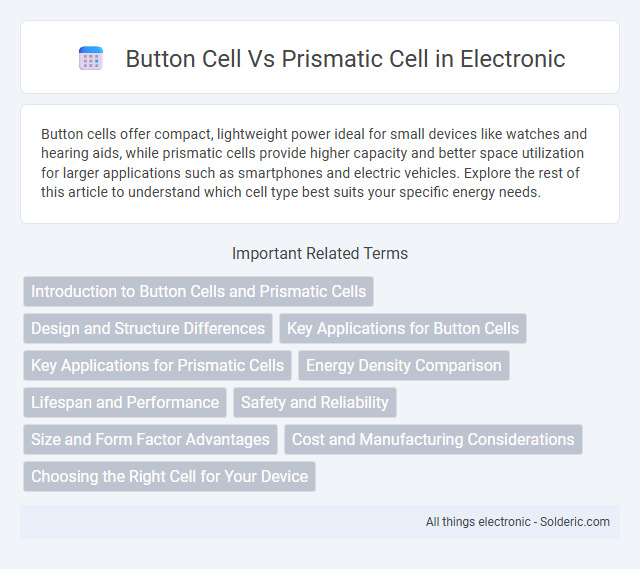Button cells offer compact, lightweight power ideal for small devices like watches and hearing aids, while prismatic cells provide higher capacity and better space utilization for larger applications such as smartphones and electric vehicles. Explore the rest of this article to understand which cell type best suits your specific energy needs.
Comparison Table
| Feature | Button Cell | Prismatic Cell |
|---|---|---|
| Shape | Small, round, thin | Rectangular, flat |
| Size | Diameter: 5-25 mm | Varies, generally larger |
| Capacity | Low (mAh range) | High (Ah range) |
| Voltage | 1.5V to 3V | 3.6V to 4.2V |
| Applications | Watches, hearing aids, small electronics | Electric vehicles, energy storage, laptops |
| Energy Density | Moderate | High |
| Cost | Low per unit, but limited energy | Higher per unit, but cost-effective for capacity |
| Rechargeability | Primarily non-rechargeable (some rechargeable types) | Rechargeable |
| Manufacturing Complexity | Simple | Complex |
Introduction to Button Cells and Prismatic Cells
Button cells are small, round batteries commonly used in compact electronic devices like watches, calculators, and hearing aids due to their compact size and stable voltage output. Prismatic cells feature a rectangular shape with a larger capacity, often found in smartphones, tablets, and electric vehicles, providing higher energy density and better utilization of space. Understanding the differences between button cells and prismatic cells helps you select the appropriate battery type based on device size, power requirements, and longevity.
Design and Structure Differences
Button cells feature a compact, disc-shaped design with a flat, circular structure ideal for small electronic devices, while prismatic cells have a rectangular, flat form factor optimized for maximizing battery capacity within slim spaces. The metal casing of button cells is sealed tightly to prevent leakage, whereas prismatic cells often use a laminated or rigid metal shell to support higher energy density and structural integrity. Your choice between these two depends on space constraints and power requirements in your device's design.
Key Applications for Button Cells
Button cells, characterized by their compact, disc-shaped design, are predominantly used in small electronic devices such as wristwatches, hearing aids, calculators, and small medical devices like glucometers. Their high energy density and long shelf life make them ideal for low-drain applications requiring a reliable power source in a minimal form factor. Unlike prismatic cells, which are favored in larger devices like smartphones and tablets, button cells excel in precision electronics due to their stable voltage output and compact size.
Key Applications for Prismatic Cells
Prismatic cells are widely used in electric vehicles (EVs), laptops, and energy storage systems due to their high energy density and space-efficient rectangular design. These cells provide better thermal management and structural stability, making them ideal for applications requiring compact, high-capacity power sources. Their adaptability in size and shape supports integration into slim portable electronics and large battery packs in renewable energy solutions.
Energy Density Comparison
Prismatic cells offer higher energy density compared to button cells due to their larger size and optimized rectangular design, which allows for more active material inside. Button cells, while compact and convenient for small electronics, typically have lower energy density, limiting their use in high-power or long-duration applications. Understanding this difference helps you choose the right cell type based on energy requirements and device constraints.
Lifespan and Performance
Button cells typically offer shorter lifespan and lower energy capacity compared to prismatic cells, making them suitable for low-drain devices like watches or small electronics. Prismatic cells provide higher energy density and longer cycle life, optimizing performance in applications requiring sustained power, such as smartphones and electric vehicles. The difference in electrode structure and casing design significantly impacts thermal management and overall efficiency between the two battery types.
Safety and Reliability
Button cells offer high energy density in compact sizes but carry risks of leakage and short-circuiting if damaged, which can compromise safety and reliability. Prismatic cells feature robust casing designs that enhance structural integrity and reduce the risk of swelling or leakage, providing more consistent performance under stress. Your choice between the two should weigh these factors, as prismatic cells tend to offer superior safety and long-term reliability in demanding applications.
Size and Form Factor Advantages
Button cells offer a compact, round shape ideal for small electronic devices such as watches and hearing aids, maximizing space efficiency in tight compartments. Prismatic cells provide a rectangular, flat form factor that enables better stacking and enhanced use of available battery compartment volume, suitable for smartphones and tablets. The prismatic design also allows for higher capacity within a thinner profile compared to the limited space optimization of button cells.
Cost and Manufacturing Considerations
Button cells typically have lower manufacturing costs due to their simple design and smaller size, making them ideal for low-power devices like watches and hearing aids. Prismatic cells, while more expensive to produce, offer higher energy density and customized shapes to fit specific device requirements, which can justify the increased cost in applications like smartphones and electric vehicles. Your choice depends on balancing budget constraints with performance needs, as prismatic cells require more advanced manufacturing processes and materials.
Choosing the Right Cell for Your Device
Selecting between button cells and prismatic cells depends on device size, energy requirements, and discharge rates. Button cells, compact and lightweight, suit small devices like watches and hearing aids, offering stable voltage with limited capacity. Prismatic cells provide higher capacity and better energy density, ideal for larger portable electronics or devices needing prolonged power supply.
Button cell vs Prismatic cell Infographic

 solderic.com
solderic.com